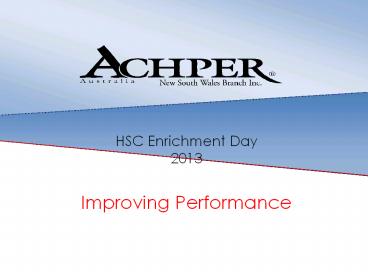HSC Enrichment Day - PowerPoint PPT Presentation
1 / 12
Title: HSC Enrichment Day
1
HSC Enrichment Day 2013 Improving
Performance
2
Workshop Overview
3
Planning a Training Year (periodisation)
Periodisation is the organised division of
training into a number of specific blocks,
periods or phases.
- These are further characterised by training
sub-phases of varying durations termed - Macro-cycles
- Mesco-cycles
- Micro-cycles
There are 3 key training phases 1.
Pre-season 2. In-season 3. Off-season
Eg. In Triathlon
Phases of competition Pre-season Pre-season Pre-season Pre-season Pre-season Pre-season In-Season In-Season In-Season In-Season In-Season In-Season Off-Season Off-Season Off-Season Off-Season Off-Season Off-Season
Macrocycles
Mesocycles
Microcycles
4
Planning a Training Year (periodisation)
Periodization is planned long-term variation of
the volume and intensity of training to prevent
overtraining and promote optimal performance at
the desired time.
The benefits of periodisation
Principle of Training Benefit
Reversibility Helps prevent overtraining by ensuring adequate recovery, at same time not allowing fitness levels to decrease
Specificity Each phase is designed to prepare a specific performance component (eg. aerobic endurance)
Variety Training is split into smaller units to maintain motivation, avoid boredom, overtraining and allow recovery.
Overload Allows athlete to manipulate training intensity, volume and frequency.
A well planned, periodized training program gives
a triathlete the confidence to enter the
competitive season knowing that they are well
prepared in all areas of their training.
5
Phases of Competition
The 3 phases of competition in a training plan
are based around the competitive year and season.
6
Subphases
Each phase of competition includes subphases
where general more sport specific abilities are
developed. The length of each phase will depend
on the Triathletes aims. Eg
- Macro-cycle
- A yearly program with the aim of peaking for a
specific event. The focus is long-term
objectives. eg. 1 year (Foster Triathlon) or 4
years (Olympics)
- Micro-cycle
- A training week within the meso-cycle
- Training unit/day within that week
- the smallest time frame considered in a
periodisation plan - The focus is specific needs at each training
session. Eg skill development
- Meso-cycle
- A phase (eg. 4 6 week blocks)
- The focus is specific training objectives, e.g.
increasing muscular endurance.
http//www.youtube.com/watch?vEKpRKcSb2OQ
7
Peaking
Coaches use the term peaking to describe the
athlete being in the absolute best condition at
a specific time for a specific competition. The
most important goal for coaches and Triathletes
is to increase the competitive abilities to
maximal levels, and to design a well controlled
training program to ensure that peak performance
is attained at each point of a major triathlon
competition.
- In order to achieve a peak at the right time,
coaches should - Follow a training plan mapping out each phase
of competition - Follow the Principles of Training
- Monitor volume and intensity of training eg.
Recording sets, reps, skill work, heart rate - Ensure the training program includes a taper
period
http//www.youtube.com/watch?vvbZvTpiif9Y
8
Tapering
Tapering is a special training period immediately
preceding the major competition during which the
training stimulus is reduced in a systematic
fashion to achieve a peak in performance
- Benefits of tapering
- When the training impulse is decreased, fatigue
decreases more rapidly than fitness, and
increased performance results from the increasing
difference between the two factors. - In a well-designed taper, the body becomes rested
(with all the associated benefits) and the
athletes fitness level is well maintained. - Full replenishment of the glycogen stores in your
muscles and liver - Heightened mental confidence psychologically
prepared for competition
? Improves Performance
9
Tapering
- For eg, in triathlon
- An effective taper has been shown to improve
performance by up to 6 in well-trained athletes. - During the taper, the focus of training is on the
athletes the weakest discipline - Reduce the volume of training
- Maintain the intensity of training
- Reduce frequency of training
- Every athlete is different, so practice the taper
to perfect it before the key race
http//www.youtube.com/watch?vviiAR3UFlUY
10
Sport-Specific Subphases
- During the various sub-phases , training for
Triathlon focuses on specifics such as - fitness components
- skill requirements
The sport-specific subphases develop follow
principles of training overload, specificity,
reversibility
11
Planning to Avoid Overtraining
Overtraining occurs in athletes who are training
for a specific event and train beyond the body's
ability to recover.
Athletes often exercise longer and harder so they
can improve. But without adequate rest and
recovery, these training regimens can backfire,
and actually decrease performance. Too much
overload and/or too little recovery may result in
both physical and psychology symptoms of
overtraining syndrome.
Overtraining syndrome is an accumulation of
training stores that results in a decrease in
performance that even with recovery may last
weeks or even months.
12
Planning to Avoid Overtraining
Signs and symptoms of overtraining
- Lack of training
http//www.youtube.com/watch?voEituo-Y_ms































